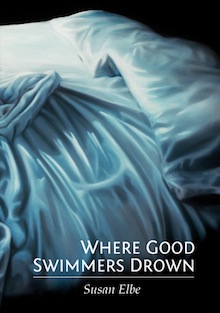Book Review
Susan Elbe, Where Good Swimmers Drown, Concrete Wolf, 2012
Reviewed by Linda Aschbrenner
Where Good Swimmers Drown by Wisconsin poet Susan Elbe won the 2011 Concrete Wolf Poetry Chapbook Award. Elbe writes with a command of craft and form in this collection of 24 poems that delve into the joy, complexity, and misgivings of love along with the tumble of emotions when love ends. The narrator’s voice resonates with honesty and courage.
Concrete Wolf, the publisher in Kingston, Washington, selected captivating cover art (Night Tide by Eric Zener), utilized a larger (easier to read) text font, and provided an attractive table of contents along with an appealing placement of the poems on each page.
Susan Elbe’s books: Eden in the Rearview Mirror (Word Press), the chapbook, Light Made from Nothing (Parallel Press), and forthcoming,The Map of What Happened, winner of the Backwaters Press Poetry Prize in 2012.
The poems in Where Good Swimmers Drown appear professionally at home on the page as Elbe frequently writes in couplets, tercets, quatrains, and cinquains. If a poem has two stanzas, they are likely to possess an equal number of lines. Poems with indented words also look tidy, thoughtful, pleasing, symmetrical. We see a poem before we read it. If the lines emerge so carefully weeded and watered, what can we expect of the words?
Elbe does not disappoint. She is not afraid to address or imagine raw, deep, and painful experiences to the extent that we are inclined to be empathetic, wanting to offer words of encouragement and cheer to the narrator.
“How to Fall” begins sentences with these verbs: start, realize, steer, listen, remember, know, leave, eat, spread, be, want. (Start by leaving home. Steer between the stars. Light a torch. Eat walnuts and persimmons. Be a whisper …. Be hungry. Want.) (pages 4 - 5) Poet readers will fight an urge to quit reading on the spot and try to duplicate such a strong form using their own imperative sentences.
Elbe makes effective use of refrain and repetition in several poems. “Putting Love in Its Place” repeats these haunting phrases: this is how, this is where, this is why. Again, who can resist writing a poem following Elbe’s lead. “Virgo” uses this refrain of contrast four times: You think …, but I am …. “All Night the Snow” utilizes anaphora starting six lines with All night in a 25-line poem. Refrain in this book helps to structure a poem. In addition, refrain becomes a way to temper, space, stall, analyze, order, explain, and come to terms with pain or other emotions.
Three lovely lines in “Putting Love in Its Place”: “a dim-lamped room / of memory, its flimsy curtains / blowing summer in.”
In “My, What Big Wishes I Had,” a 15-line form poem, rhyme plays through the three stanzas down to the ironic last line. The title? I think of Little Red Riding Hood entering her grandmother’s house and denying the obvious. Emotions and expectations cloud vision. One wishes what one wants to wish even while reality intones run for your life.
The first four lines in "Dead-Eye Moth" shine with fresh images while employing iambics, rhyme, and alliteration along with energetic verbs and surprising adjectives. The word flimsy sounds flimsy. Contrast exists between the repetition of the s sound and the puff of wind in hunting, the clip of the c:
Iris rust and yellow jackets tango in the eaves
hunting windless homes.
Summer’s crude seams pull apart,
life straining at its flimsy clothes. (page 10)
“Lunar” mentions an array of moons under which things happened in the love relationship—on the upslope and decline. Indeed, if a blue moon glows, why not other fabulous moons? Susan Elbe invents the New Flowers Opening Moon, Sunburn Moon, Sturgeon Moon, Moon of Spiderwebs on the Ground, and Fall From Moon. One wants to run with this idea and name other moons and suns, months and years, other coffee mugs and pillows.
Two poignant poems: “Horses in Virginia in November” describes two horses in a field with the refrain “They need each other.” The closing line, “they have each other.” This poem reads as if there is no place to go, no place on earth to escape to that is not a reminder of loss and being alone. The second poem, “In the Stunned Light of October,” is in a form that will emphasize the last word in the last stanza. This stanza reads, “It’s not the move, it’s the nature of the move. / If only you hadn’t said / maybe.” The poem ends with this life-changing word.
Linda Aschbrenner is the editor/publisher of Marsh River Editions. She edited and published the poetry journal Free Verse from 1998 to 2009 which now continues as Verse Wisconsin. She lives in Marshfield and is presently lost in the 1950s as she works on a book of family memories with her two sisters, Elda Lepak and Mavis Flegle.


